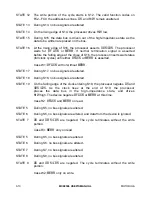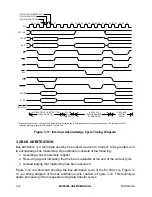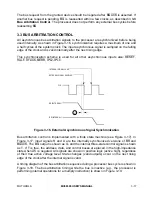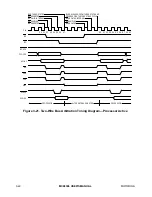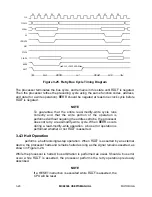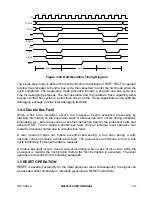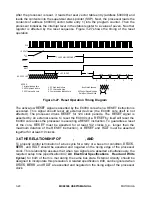
3- 16
MC68306 USER'S MANUAL
MOTOROLA
The timing diagram in Figure 3-14 shows that the bus request is negated at the time that
an acknowledge is asserted. This type of operation applies to a system consisting of a
processor and one other device capable of becoming bus master. In systems having
several devices that can be bus masters, bus request lines from these devices can be
wire-ORed at the processor, and more than one bus request signal could occur.
The bus grant signal is negated a few clock cycles after the assertion of the bus grant
acknowledge signal. However, if bus requests are pending, the processor reasserts bus
grant for another request a few clock cycles after bus grant (for the previous request) is
negated. In response to this additional assertion of bus grant, external arbitration circuitry
selects the next bus master before the current bus master has completed the bus activity.
The timing diagram in Figure 3-15 also applies to a system consisting of a processor and
one other device capable of becoming bus master. Since the 2-wire bus arbitration
scheme does not use a bus grant acknowledge signal, the external master must continue
to assert
BR
until it has completed its bus activity. The processor negates bus grant when
BR
is negated.
3.2.1 Requesting the Bus
External devices capable of becoming bus masters assert
BR
to request the bus. This
signal can be wire-ORed (not necessarily constructed from open-collector devices) from
any of the devices in the system that can become bus master. The processor, which is at
a lower bus priority level than the external devices, relinquishes the bus after it completes
the current bus cycle.
3.2.2 Receiving the Bus Grant
The processor asserts
BG
as soon as possible. Normally, this process immediately
follows internal synchronization, except when the processor has made an internal decision
to execute the next bus cycle but has not yet asserted
AS
for that cycle. In this case,
BG
is
delayed until
AS
is asserted to indicate to external devices that a bus cycle is in progress.
BG
can be routed through a daisy-chained network or through a specific priority-encoded
network. Any method of external arbitration that observes the protocol can be used.
3.2.3 Acknowledgment of Mastership (3-Wire Bus Arbitration Only)
Upon receiving
BG
, the requesting device waits until
AS
,
DTACK
, and
BGACK
are
negated before asserting
BGACK
. The negation of
AS
indicates that the previous bus
master has completed its cycle. (No device is allowed to assume bus mastership while
AS
is asserted.) The negation of
BGACK
indicates that the previous master has released the
bus. The negation of
DTACK
indicates that the previous slave has terminated the
connection to the previous master. (In some applications,
DTACK
might not be included in
this function; general-purpose devices would be connected using
AS
only.) When
BGACK
is asserted, the asserting device is bus master until it negates
BGACK
.
BGACK
should not
be negated until after the bus cycle(s) is complete. A device relinquishes control of the bus
by negating
BGACK
.









